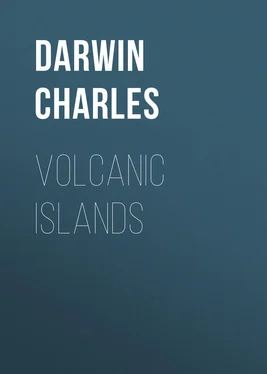Charles Darwin - Volcanic Islands
Здесь есть возможность читать онлайн «Charles Darwin - Volcanic Islands» — ознакомительный отрывок электронной книги совершенно бесплатно, а после прочтения отрывка купить полную версию. В некоторых случаях можно слушать аудио, скачать через торрент в формате fb2 и присутствует краткое содержание. Жанр: foreign_antique, foreign_prose, на английском языке. Описание произведения, (предисловие) а так же отзывы посетителей доступны на портале библиотеки ЛибКат.
- Название:Volcanic Islands
- Автор:
- Жанр:
- Год:неизвестен
- ISBN:нет данных
- Рейтинг книги:5 / 5. Голосов: 1
-
Избранное:Добавить в избранное
- Отзывы:
-
Ваша оценка:
- 100
- 1
- 2
- 3
- 4
- 5
Volcanic Islands: краткое содержание, описание и аннотация
Предлагаем к чтению аннотацию, описание, краткое содержание или предисловие (зависит от того, что написал сам автор книги «Volcanic Islands»). Если вы не нашли необходимую информацию о книге — напишите в комментариях, мы постараемся отыскать её.
Volcanic Islands — читать онлайн ознакомительный отрывок
Ниже представлен текст книги, разбитый по страницам. Система сохранения места последней прочитанной страницы, позволяет с удобством читать онлайн бесплатно книгу «Volcanic Islands», без необходимости каждый раз заново искать на чём Вы остановились. Поставьте закладку, и сможете в любой момент перейти на страницу, на которой закончили чтение.
Интервал:
Закладка:
Fragments of the scoriae embedded in the calcareous mass, when broken, exhibit many of their cells lined and partly filled with a white, delicate, excessively fragile, moss-like, or rather conferva-like, reticulation of carbonate of lime. These fibres, examined under a lens of one-tenth of an inch focal distance, appear cylindrical; they are rather above one- thousandth of an inch in diameter; they are either simply branched, or more commonly united into an irregular mass of network, with the meshes of very unequal sizes and of unequal numbers of sides. Some of the fibres are thickly covered with extremely minute spicula, occasionally aggregated into little tuffs; and hence they have a hairy appearance. These spicula are of the same diameter throughout their length; they are easily detached, so that the object-glass of the microscope soon becomes scattered over with them. Within the cells of many fragments of the scoria, the lime exhibits this fibrous structure, but generally in a less perfect degree. These cells do not appear to be connected with one another. There can be no doubt, as will presently be shown, that the lime was erupted, mingled with the lava in its fluid state, and therefore I have thought it worth while to describe minutely this curious fibrous structure, of which I know nothing analogous. From the earthy condition of the fibres, this structure does not appear to be related to crystallisation.
Other fragments of the scoriaceous rock from this hill, when broken, are often seen marked with short and irregular white streaks, which are owing to a row of separate cells being partly, or quite, filled with white calcareous powder. This structure immediately reminded me of the appearance in badly kneaded dough, of balls and drawn-out streaks of flour, which have remained unmixed with the paste; and I cannot doubt that small masses of the lime, in the same manner remaining unmixed with the fluid lava, have been drawn out when the whole was in motion. I carefully examined, by trituration and solution in acids, pieces of the scoriae, taken from within half-an-inch of those cells which were filled with the calcareous powder, and they did not contain an atom of free lime. It is obvious that the lava and lime have on a large scale been very imperfectly mingled; and where small portions of the lime have been entangled within a piece of the viscid lava, the cause of their now occupying, in the form of a powder or of a fibrous reticulation, the vesicular cavities, is, I think, evidently due to the confined gases having most readily expanded at the points where the incoherent lime rendered the lava less adhesive.
A mile eastward of the town of Praya, there is a steep-sided gorge, about one hundred and fifty yards in width, cutting through the basaltic plain and underlying beds, but since filled up by a stream of more modern lava. This lava is dark grey, and in most parts compact and rudely columnar; but at a little distance from the coast, it includes in an irregular manner a brecciated mass of red scoriae mingled with a considerable quantity of white, friable, and in some parts, nearly pure earthy lime, like that on the summit of Red Hill. This lava, with its entangled lime, has certainly flowed in the form of a regular stream; and, judging from the shape of the gorge, towards which the drainage of the country (feeble though it now be) still is directed, and from the appearance of the bed of loose water-worn blocks with their interstices unfilled, like those in the bed of a torrent, on which the lava rests, we may conclude that the stream was of subaerial origin. I was unable to trace it to its source, but, from its direction, it seemed to have come from Signal Post Hill, distant one mile and a quarter, which, like Red Hill, has been a point of eruption subsequent to the elevation of the great basaltic plain. It accords with this view, that I found on Signal Post Hill, a mass of earthy, calcareous matter of the same nature, mingled with scoriae. I may here observe that part of the calcareous matter forming the horizontal sedimentary bed, especially the finer matter with which the embedded fragments of rock are whitewashed, has probably been derived from similar volcanic eruptions, as well as from triturated organic remains: the underlying, ancient, crystalline rocks, also, are associated with much carbonate of lime, filling amygdaloidal cavities, and forming irregular masses, the nature of which latter I was unable to understand.
Considering the abundance of earthy lime near the summit of Red Hill, a volcanic cone six hundred feet in height, of subaerial growth, – considering the intimate manner in which minute particles and large masses of scoriae are embedded in the masses of nearly pure lime, and on the other hand, the manner in which small kernels and streaks of the calcareous powder are included in solid pieces of the scoriae, – considering, also, the similar occurrence of lime and scoriae within a stream of lava, also supposed, with good reason, to have been of modern subaerial origin, and to have flowed from a hill, where earthy lime also occurs: I think, considering these facts, there can be no doubt that the lime has been erupted, mingled with the molten lava. I am not aware that any similar case has been described: it appears to me an interesting one, inasmuch as most geologists must have speculated on the probable effects of a volcanic focus, bursting through deep-seated beds of different mineralogical composition. The great abundance of free silex in the trachytes of some countries (as described by Beudant in Hungary, and by P. Scrope in the Panza Islands), perhaps solves the inquiry with respect to deep-seated beds of quartz; and we probably here see it answered, where the volcanic action has invaded subjacent masses of limestone. One is naturally led to conjecture in what state the now earthy carbonate of lime existed, when ejected with the intensely heated lava: from the extreme cellularity of the scoriae on Red Hill, the pressure cannot have been great, and as most volcanic eruptions are accompanied by the emission of large quantities of steam and other gases, we here have the most favourable conditions, according to the views at present entertained by chemists, for the expulsion of the carbonic acid. (Whilst deep beneath the surface, the carbonate of lime was, I presume, in a fluid state. Hutton, it is known, thought that all amygdaloids were produced by drops of molten limestone floating in the trap, like oil in water: this no doubt is erroneous, but if the matter forming the summit of Red Hill had been cooled under the pressure of a moderately deep sea, or within the walls of a dike, we should, in all probability, have had a trap rock associated with large masses of compact, crystalline, calcareous spar, which, according to the views entertained by many geologists, would have been wrongly attributed to subsequent infiltration.) Has the slow re- absorption of this gas, it may be asked, given to the lime in the cells of the lava, that peculiar fibrous structure, like that of an efflorescing salt? Finally, I may remark on the great contrast in appearance between this earthy lime, which must have been heated in a free atmosphere of steam and other gases, while the white, crystalline, calcareous spar, produced by a single thin sheet of lava (as at Quail Island) rolling over similar earthy lime and the debris of organic remains, at the bottom of a shallow sea.
SIGNAL POST HILL.
This hill has already been several times mentioned, especially with reference to the remarkable manner in which the white calcareous stratum, in other parts so horizontal (Figure 2), dips under it into the sea. It has a broad summit, with obscure traces of a crateriform structure, and is composed of basaltic rocks (Of these, one common variety is remarkable for being full of small fragments of a dark jasper-red earthy mineral, which, when examined carefully, shows an indistinct cleavage; the little fragments are elongated in form, are soft, are magnetic before and after being heated, and fuse with difficulty into a dull enamel. This mineral is evidently closely related to the oxides of iron, but I cannot ascertain what it exactly is. The rock containing this mineral is crenulated with small angular cavities, which are lined and filled with yellowish crystals of carbonate of lime.), some compact, others highly cellular with inclined beds of loose scoriae, of which some are associated with earthy lime. Like Red Hill, it has been the source of eruptions, subsequently to the elevation of the surrounding basaltic plain; but unlike that hill, it has undergone considerable denudation, and has been the seat of volcanic action at a remote period, when beneath the sea. I judge of this latter circumstance from finding on its inland flank the last remains of three small points of eruption. These points are composed of glossy scoriae, cemented by crystalline calcareous spar, exactly like the great submarine calcareous deposit, where the heated lava has rolled over it: their demolished state can, I think, be explained only by the denuding action of the waves of the sea. I was guided to the first orifice by observing a sheet of lava, about two hundred yards square, with steepish sides, superimposed on the basaltic plain with no adjoining hillock, whence it could have been erupted; and the only trace of a crater which I was able to discover, consisted of some inclined beds of scoriae at one of its corners. At the distance of fifty yards from a second level-topped patch of lava, but of much smaller size, I found an irregular circular group of masses of cemented, scoriaceous breccia, about six feet in height, which doubtless had once formed the point of eruption. The third orifice is now marked only by an irregular circle of cemented scoriae, about four yards in diameter, and rising in its highest point scarcely three feet above the level of the plain, the surface of which, close all round, exhibits its usual appearance: here we have a horizontal basal section of a volcanic spiracle, which, together with all its ejected matter, has been almost totally obliterated.
Читать дальшеИнтервал:
Закладка:
Похожие книги на «Volcanic Islands»
Представляем Вашему вниманию похожие книги на «Volcanic Islands» списком для выбора. Мы отобрали схожую по названию и смыслу литературу в надежде предоставить читателям больше вариантов отыскать новые, интересные, ещё непрочитанные произведения.
Обсуждение, отзывы о книге «Volcanic Islands» и просто собственные мнения читателей. Оставьте ваши комментарии, напишите, что Вы думаете о произведении, его смысле или главных героях. Укажите что конкретно понравилось, а что нет, и почему Вы так считаете.












